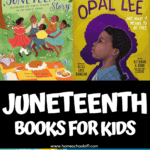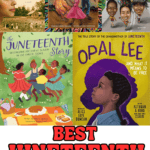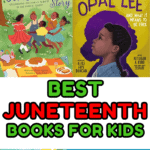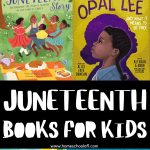19 Best Juneteenth Books for Kids
When I first started looking for Juneteenth books for kids, I wasn’t just searching for a history lesson. I wanted stories that would help my child feel the weight and joy of the day.
It mattered to me that the books we chose didn’t just explain the facts, but sparked real conversations about freedom, resilience, and hope.
Over time, we found a handful of beautiful, meaningful books that opened those doors for us.
These are the stories that helped us connect with Juneteenth in a way that felt personal, memorable, and truly important.
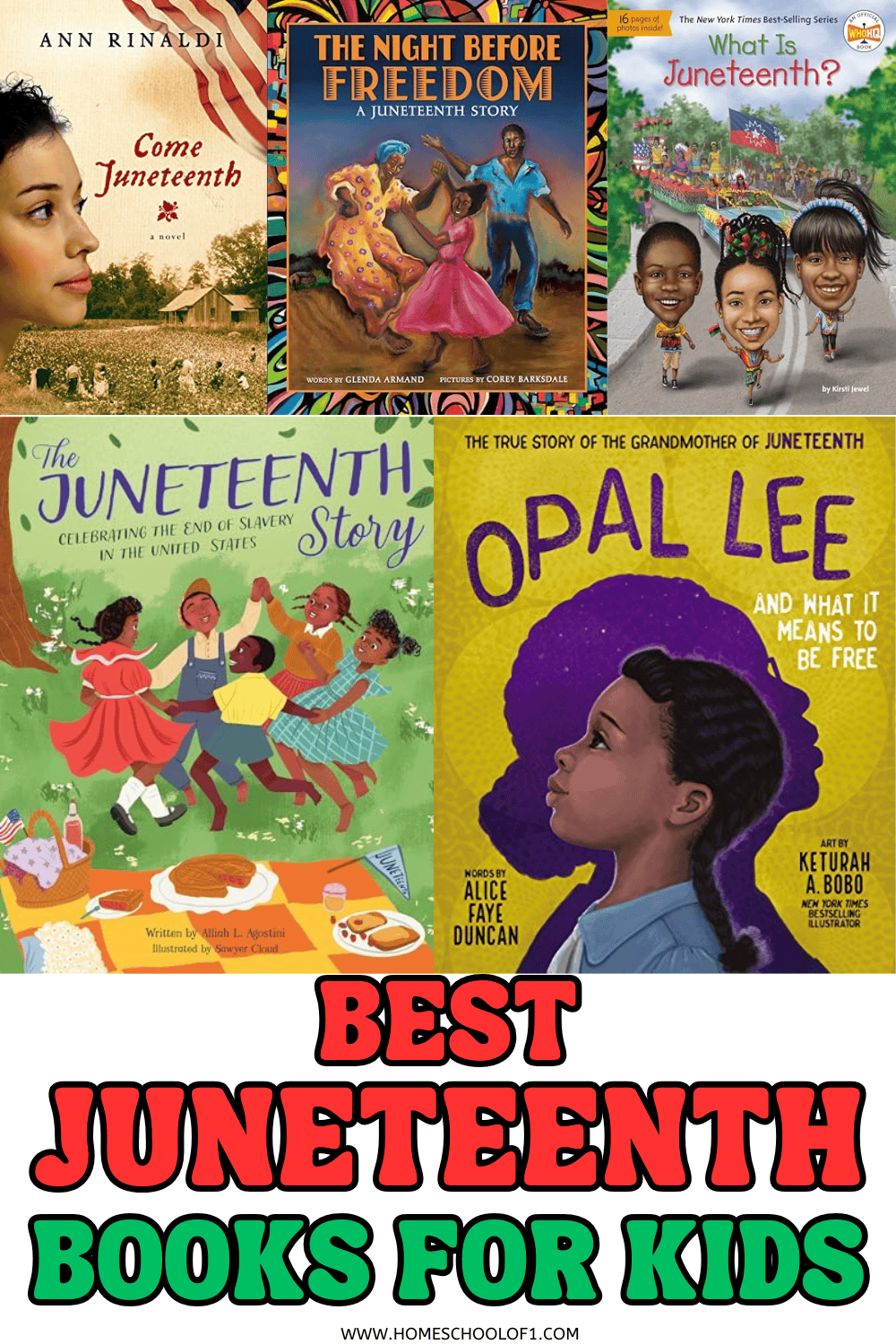
**This post may contain affiliate links. As an Amazon Associate and a participant in other affiliate programs, I earn a commission on qualifying purchases.**
Books About Juneteenth for Kids
Sharing Juneteenth with my son has been about more than just teaching dates and facts. It’s been about finding stories that invite empathy and reflection.
The books on this list offer rich illustrations, powerful storytelling, and an age-appropriate way to explore the meaning behind the holiday.
They’ve helped turn important conversations about freedom, perseverance, and history into something we could build on together, one story at a time.
The first time I read All Different Now, I remember stopping at almost every page just to take in the artwork. The story feels soft but powerful, showing Juneteenth through a child's quiet observations. It captures that emotional shift from ordinary life to a brand-new freedom in a way that lingers long after the last page.
I appreciate how this book makes Juneteenth understandable without oversimplifying it. It lays out the key events clearly, making it a great starting point for kids who are just beginning to ask deeper questions about American history. It reads more like a conversation than a lecture, which makes a big difference.
Mazie’s story feels honest in a way that a lot of holiday books don’t always capture. There’s impatience, frustration, pride—all layered together as she learns why Juneteenth matters. It's a reminder that understanding history isn’t always neat or easy, but it’s important, and that feeling comes through on every page.
What stood out to me about this book was its steady, gentle tone. It doesn’t rush through the facts or try to dress them up; it explains why Juneteenth is meaningful with a quiet confidence. It's the kind of book that makes space for readers to ask their own questions, instead of trying to answer everything at once.
I don't usually gravitate toward interactive history books, but this one is smartly done. The different story paths pull you into the experience, making it feel less like a timeline and more like real choices people had to make. It’s a creative way to teach about a complex event without losing its weight.
What I love about this book is that it focuses on joy without glossing over the hardship. The storytelling feels rhythmic and hopeful, and the bright illustrations carry so much emotion. It’s a celebration of freedom that feels alive, perfect for reminding kids (and adults) that history is full of resilience and happiness.
This book keeps things simple without feeling watered down, which isn’t easy when talking about something as big as Juneteenth. The language feels accessible, and the visuals help anchor the ideas in a way that feels real. It’s the kind of book that works especially well for younger kids who are just starting to connect history to real people’s lives.
There’s a warmth to this book that caught me off guard. It highlights not just the end of slavery, but the enduring spirit that followed. The illustrations are bold and full of motion, almost like you can hear the music and laughter rising off the page. It's a reminder that freedom is something to honor — and to celebrate fully.
Out of all the nonfiction titles, this one probably answers the most questions without ever feeling heavy. It’s straightforward but lively, weaving together history and cultural traditions in a way that holds attention. It’s the kind of book you can return to as kids’ understanding deepens over time.
There’s something deeply moving about the way this story focuses on the creation of the Juneteenth flag. The narrative feels personal and almost intimate, showing how symbols can hold layers of meaning for a whole community. The quilt-style illustrations add so much texture — both visually and emotionally.
Even though it’s brief, this poem carries so much weight. It doesn’t try to explain everything; it just lets the emotions speak for themselves. Reading it feels like sitting quietly with history — the sorrow, the hope, the pride — all woven together in a few powerful lines.
This book feels almost like a letter — personal, heartfelt, and direct. It offers a softer, story-driven way into the history, making it feel less distant and more like something still living and breathing today. It’s one of those titles that sticks with you because it feels spoken, not just written.
This book captures the excitement and discovery of experiencing Juneteenth for the first time. The energy practically jumps off the page, from the colorful celebrations to the heartfelt storytelling. It feels like being invited to a community event where joy and history are woven together, and you can't help but want to stay awhile.
What stands out here is how the book strikes a balance between giving historical depth and keeping things engaging. It doesn’t shy away from the complexity of Juneteenth, but it presents everything in a way that's clear and thoughtful. It’s a strong pick for kids who are ready to dig a little deeper without feeling overwhelmed.
This book makes you slow down and feel the significance of the day. It’s not just about marking a date; it’s about honoring the emotions tied to it—relief, pride, resilience. The writing pulls you into the moment, and the vivid illustrations make the celebrations feel almost tangible.
This one feels a little more like a bridge between a storybook and a history text, but in a good way. It covers the background, traditions, and ongoing relevance of Juneteenth with a respectful, steady tone. It's a reminder that freedom is an ongoing story, not just a moment in the past.
There’s so much heart in this story. Opal Lee’s determination feels contagious—the kind of story that makes you want to stand up and do something good. It’s an inspiring look at how one person’s persistence can ripple out and change a country, all told in a way that feels approachable and real.
The anticipation woven into this story feels almost electric. It captures that sense of waiting and wondering what freedom will actually look like. The emotions are so tangible that it almost feels like you’re standing alongside the characters, listening for the news to finally break.
This historical novel digs deeper than most, showing how complicated freedom was for the families living through it. The characters wrestle with loyalty, truth, and justice in ways that feel painfully real. It’s not always an easy read, but it leaves a lasting impression—one that pushes you to think harder about the choices people faced, and what freedom really meant.
Juneteenth Activities
After reading and reflecting, it’s meaningful to give kids creative ways to connect even more deeply with Juneteenth. These simple activities combine learning, conversation, and a little bit of fun:
- Juneteenth word search: Search for important words like freedom, emancipation, and heritage, and use them as conversation starters about what each one means.
- Juneteenth color by number: Explore Juneteenth themes through art, with coloring pages that highlight symbols of freedom and celebration.
- Juneteenth word scramble: Solve puzzles using words like proclamation and abolish, helping kids link key ideas to the larger story of Juneteenth.
No matter how you celebrate, taking time to honor Juneteenth helps keep the story of freedom alive for future generations.
Last Updated on 28 April 2025 by Clare Brown

